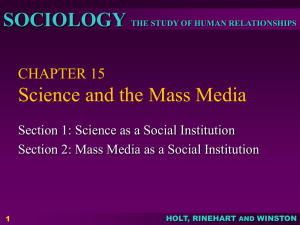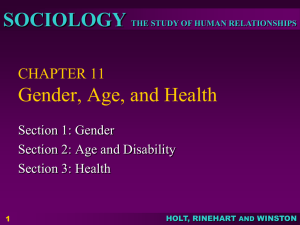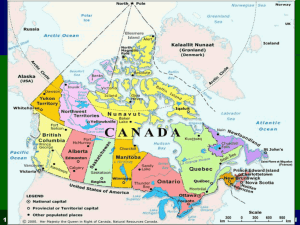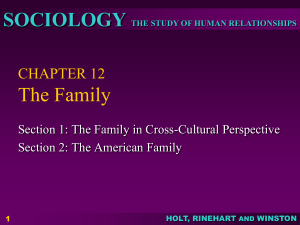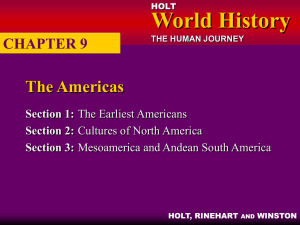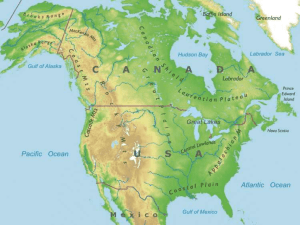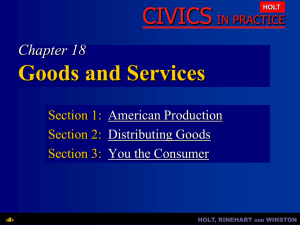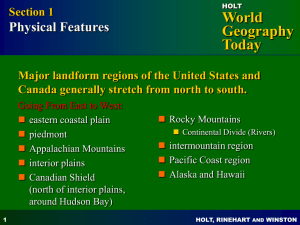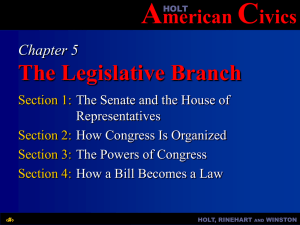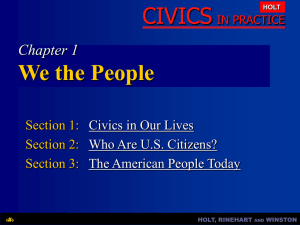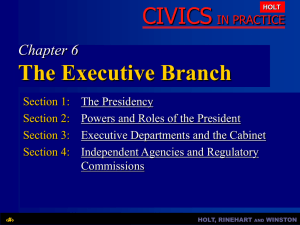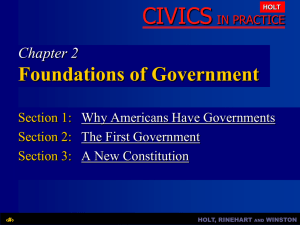civ_ch23 - Bullitt Blogs
advertisement
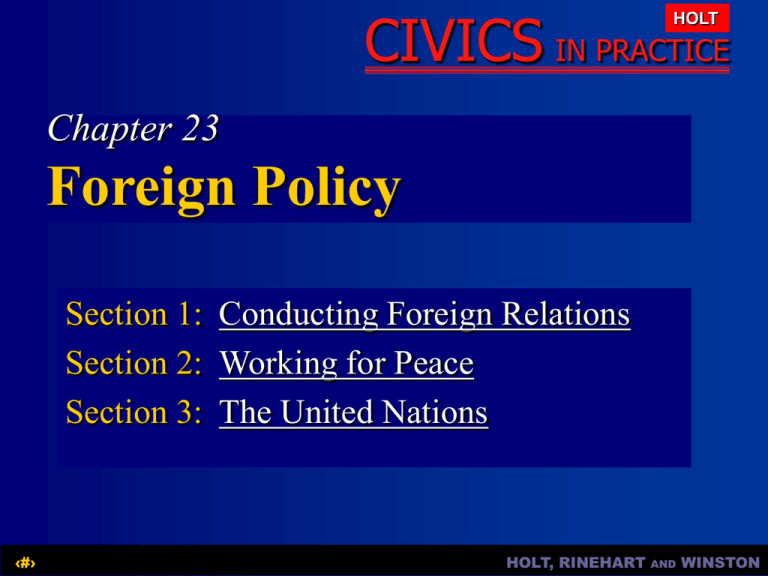
CIVICS IN PRACTICE HOLT Chapter 23 Foreign Policy Section 1: Conducting Foreign Relations Section 2: Working for Peace Section 3: The United Nations ‹#› HOLT, RINEHART AND WINSTON CIVICS IN PRACTICE HOLT Section 1: Conducting Foreign Relations The Main Idea The United States has relationships with many foreign countries. Both the president and Congress play roles in conducting foreign policy. ‹#› Reading Focus What are the goals of U.S. foreign policy? What are the president’s military and diplomatic powers? What other governmental agencies help the president and Congress conduct foreign policy? How do the powers of Congress balance the president’s powers? HOLT, RINEHART AND WINSTON CIVICS IN PRACTICE HOLT Section 1: Conducting Foreign Relations The purposes of foreign policy: Maintain national security Support democracy Promote world peace Provide aid to people in need Open trade ‹#› HOLT, RINEHART AND WINSTON CIVICS IN PRACTICE HOLT Section 1: Conducting Foreign Relations The president’s military and diplomatic powers: Military powers—commander in chief: recommends military operations to Congress Diplomatic powers—makes treaties: peace treaties, alliance treaties, commercial treaties; executive agreements; appoints and receives ambassadors; diplomatic recognition ‹#› HOLT, RINEHART AND WINSTON CIVICS IN PRACTICE HOLT Section 1: Conducting Foreign Relations Congress balances the president’s authority: The Senate Foreign Relations Committee and the ‹#› House Committee on International Relations make policy recommendations to the president. Senate must approve treaties by a two-thirds vote. Only Congress can declare war. 1973—War Powers Act limited the president’s power to send troops abroad. Congress must approve all spending of public funds such as defense spending. HOLT, RINEHART AND WINSTON SECTION 1 CIVICS IN PRACTICE HOLT Question: How do the powers of Congress balance the president’s authority in foreign relations? Congress’s Foreign-Policy Powers 1. approves treaties and appointments 2. declares war 3. can invoke the War Powers Act 4. controls finances ‹#› HOLT, RINEHART AND WINSTON CIVICS IN PRACTICE HOLT Section 2: Working for Peace The Main Idea To promote peace and stability, the United States engages in diplomacy with other nations. These alliances with other countries serve mutual defense, economic, and other needs. Reading Focus Why is diplomacy important; and what alliances has the United States made with other countries to promote mutual defense? What forms can U.S. foreign aid take? What organizations exist to promote international trade and economic stability, and what does each one do? ‹#› HOLT, RINEHART AND WINSTON CIVICS IN PRACTICE HOLT Section 2: Working for Peace NATO and its purpose today: North Atlantic Treaty Organization—a united front against aggression by the Soviet Union and its communist allies; established 1949 Pledges an attack against one member is an attack against all NATO’s Partnership for Peace Program— countries participate in preparation for NATO membership ‹#› HOLT, RINEHART AND WINSTON CIVICS IN PRACTICE HOLT Section 2: Working for Peace The purpose and forms of foreign aid: Provides military or economic assistance to another country Provides food, clothing, and housing to wartorn countries. Rebuilds factories, farms, and transportation systems ‹#› HOLT, RINEHART AND WINSTON CIVICS IN PRACTICE HOLT Section 2: Working for Peace The purpose and forms of foreign aid: (continued) Helps countries maintain their independence and become self-sufficient Provides humanitarian aid Peace Corps volunteers provide teaching, engineering, agriculture, and health care assistance. ‹#› HOLT, RINEHART AND WINSTON CIVICS IN PRACTICE HOLT Section 2: Working for Peace Alliances and organizations promoting international trade and economic stability: European Union (EU)—seeks free movement of goods, workers, and capital North American Free Trade Agreement (NAFTA)— allows free trade between Canada, United States, and Mexico Asia-Pacific Economic Cooperation Group (APEC)— promotes cooperation among Asia-Pacific countries ‹#› HOLT, RINEHART AND WINSTON CIVICS IN PRACTICE HOLT Section 2: Working for Peace Alliances and organizations promoting international trade and economic stability: World Trade Organization (WTO)—sets rules for international trade International Monetary Fund (IMF)—lends funds to countries in need United Nations World Bank—offers another way for countries to cooperate ‹#› HOLT, RINEHART AND WINSTON CIVICS IN PRACTICE SECTION 2 HOLT Question: What are the various forms of U.S. foreign aid? Humanitarian Security food soldiers clothes arms shelter money workers information money The purpose of foreign aid is to provide economic or military assistance to other countries. ‹#› HOLT, RINEHART AND WINSTON CIVICS IN PRACTICE HOLT Section 3: The United Nations The Main Idea The United Nations provides a forum in which countries may discuss serious problems and work toward solutions. Reading Focus What is the United Nations and how is it organized? What is the role of the United Nations in the modern world? ‹#› HOLT, RINEHART AND WINSTON CIVICS IN PRACTICE HOLT Section 3: The United Nations The United Nations 1945—United Nations formed to promote peaceful coexistence and worldwide cooperation; countries pledged to save future generations from war. ‹#› HOLT, RINEHART AND WINSTON CIVICS IN PRACTICE HOLT Section 3: The United Nations Six Divisions General Assembly—discusses, debates, and recommends solutions to global issues Security Council—mainly responsible for peacekeeping International Court of Justice—handles international legal disputes ‹#› HOLT, RINEHART AND WINSTON CIVICS IN PRACTICE HOLT Section 3: The United Nations Six Divisions (continued) Economic and Social Council—dedicated to improving lives; conducts studies on world populations Trusteeship Council—helped non-self-governing colonies; suspended in 1994 Secretariat—manages day-to-day activities and provides services ‹#› HOLT, RINEHART AND WINSTON CIVICS IN PRACTICE HOLT Section 3: The United Nations The Economic and Social Council Improves the lives of the world’s people Studies health, human rights, education, narcotics, and world population Ensures the UN works together with specialized agencies ‹#› HOLT, RINEHART AND WINSTON CIVICS IN PRACTICE HOLT Section 3: The United Nations Functions of the specialized agencies: Work to improve the lives of the world’s people Food and Agriculture Organization (FAO)— helps countries grow better food and increase production United Nations Educational, Scientific, and Cultural Organization (UNESCO)—extends educational opportunities ‹#› HOLT, RINEHART AND WINSTON CIVICS IN PRACTICE HOLT Section 3: The United Nations Functions of the specialized agencies: (continued) World Meteorological Organization (WMO)— promotes exchange of weather reports World Bank—makes loans and gives economic and technical advice International Telecommunications Union (ITU)—promotes electronic communication ‹#› HOLT, RINEHART AND WINSTON CIVICS IN PRACTICE SECTION 3 HOLT Question: Why was the United Nations formed, and what are its six divisions? General Assembly The United Nations was formed Trusteeship Council to promote peaceful coexistence and cooperation among nations, maintain peace, and support human rights. International Court of Justice ‹#› Security Council Secretariat Economic and Social Council HOLT, RINEHART AND WINSTON CIVICS IN PRACTICE HOLT Chapter 23 Wrap-Up 1. What is the purpose of foreign policy? 2. What foreign-policy powers does Congress have? 3. Why was NATO created, and what is the Partnership for Peace program? 4. Why does the United States give foreign aid to other countries, and what forms does it take? 5. What is the purpose of the United Nations, and what are its six divisions? 6. What are the arguments for and against a permanent UN army? ‹#› HOLT, RINEHART AND WINSTON
